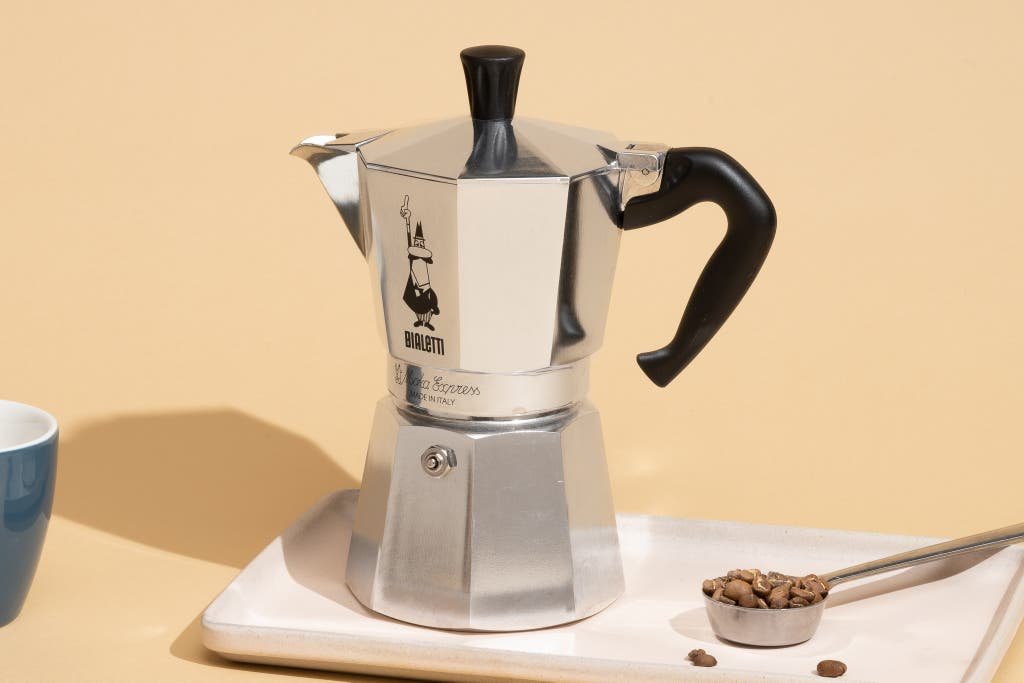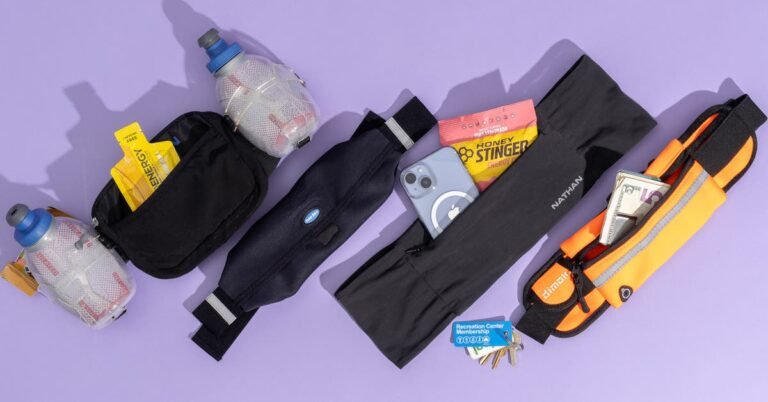
Like most of the moka pots we tested, the Moka Express is simple yet effective, lightweight yet sturdy, affordable yet stylish. It’s uncomplicated to use, unlike traditional espresso machines (which require some practice and know-how and cost hundreds of dollars or more). It’s also forgiving; other than leaving it on the stove too long and burning your coffee, there are very few ways to mess up.
The flavor of the beverage it produces is richer than the results from most of the other moka pots we tested, and much more so than coffee from a French press or a drip coffee maker. And with the sleepy-lidded eyes of l’Omino con i baffi staring at you from the side of the pot, you’re always keenly aware that you’re using a time-tested piece of Italian gadgetry.
Some of the people who once used a Moka Express to brew their morning coffee are eschewing it for newer innovations—such as the plastic-tube AeroPress, which can make a similarly concentrated cup of coffee with more clarity. But Blue Bottle’s Jessie Washburn said the Moka Express offers a ritualistic simplicity and nostalgia that are unmatched by other coffee makers.
“Early on in my coffee life, it was my first regular brewing device. I felt downright cosmopolitan leaving the plug-in coffee maker of my youth behind,” Washburn said, recalling how her grandparents would use a Moka Express to make post-lunch pots of coffee in their tiny New York City kitchen. “The coffee would gurgle and hiss as my grandmother warmed a little milk for herself. My grandfather would take his black, with a splash of boiling water to open up the flavors and stretch the coffee.”
Outside of Europe, moka pots are especially popular in Cuban communities for making café cubano—a hot, sweet drink made by whisking sugar into the first few drops of coffee before adding the rest of the pot. Lourdes Castro, a Cuban American nutritionist and director of New York University’s Food Lab, said everyone in Cuba has a moka pot at home—though they call it a cafetera—and it’s most commonly the classic Moka Express.
“If you go into someone’s kitchen to make coffee and they don’t have the silver-and-black one, you might think they don’t know what they’re doing,” she said. And it’s not just for a morning cup of joe—café cubano is an all-day affair.
“In the morning, you can mix it with some milk, and that will make it café con leche. And then in the afternoon, you can have it after lunch, and definitely again around three or four—coffee hour,” said Castro, adding that it’s also typical for some Cubans to drink a thimble-sized cup every hour.
Our tests
In my own kitchen, I conducted a taste test with four 6-cup moka pots: my Bialetti Moka Express, the Alessi Moka, the Grosche Milano Red, and the stainless steel Ilsa Turbo Express. Dozens of variations are available—from IKEA’s Scandinavian spin on the classic moka pot to the MoMA Design Store’s cute and colorful Cocca Moka to innumerable knockoffs on Amazon—but we concluded that the four models we chose represented the range of options well.
Over about a week, I made 16 pots of coffee for my taste test. I made café con leche with each moka pot using Café Bustelo, piloncillo (a compact cone of brown sugar), and whole milk. I also made black coffee with Intelligentsia Black Cat Classic Espresso beans, Intelligentsia House Blend coffee beans, and Starbucks House Blend coffee beans in each one. I also timed how long each pot took to brew 20 grams of grounds from start to finish. For each round of testing, I had my husband pour about an ounce of coffee from each moka pot into teacups, so that I could compare them blind.

I am by no means a coffee expert (as I said, I just started drinking it regularly in the past few years), but I did find some obvious differences between the pots’ brews. Compared with the rest of the bunch, the Bialetti Moka Express performed the best overall, producing a smooth, full-bodied flavor profile—chocolatey, smoky, and just a bit acidic. The Alessi Moka’s brews were a little more acidic and slightly less rich, but they were otherwise almost indistinguishable from the Bialetti’s. Results from the stainless steel Ilsa Turbo Express were drinkable, if somewhat hollow and flat, and brews from the Grosche Milano Red were the worst—watery and flavorless.
The Bialetti pot that I’ve had for years seems mostly infallible. Other than a hairline crack on the hinge, it hasn’t sustained any major damage. The cast-aluminum pieces fit together smoothly and are fairly easy to clean. When the pot is not in use, it fits into my mid-century modern decor as a piece of functional art.
More recently, I tested this stainless steel Bialetti. While it won’t replace my Moka Express, I found that would be a good alternative for people with induction ranges.
Source link
[og_img

Like most of the moka pots we tested, the Moka Express is simple yet effective, lightweight yet sturdy, affordable yet stylish. It’s uncomplicated to use, unlike traditional espresso machines (which require some practice and know-how and cost hundreds of dollars or more). It’s also forgiving; other than leaving it on the stove too long and burning your coffee, there are very few ways to mess up.
The flavor of the beverage it produces is richer than the results from most of the other moka pots we tested, and much more so than coffee from a French press or a drip coffee maker. And with the sleepy-lidded eyes of l’Omino con i baffi staring at you from the side of the pot, you’re always keenly aware that you’re using a time-tested piece of Italian gadgetry.
Some of the people who once used a Moka Express to brew their morning coffee are eschewing it for newer innovations—such as the plastic-tube AeroPress, which can make a similarly concentrated cup of coffee with more clarity. But Blue Bottle’s Jessie Washburn said the Moka Express offers a ritualistic simplicity and nostalgia that are unmatched by other coffee makers.
“Early on in my coffee life, it was my first regular brewing device. I felt downright cosmopolitan leaving the plug-in coffee maker of my youth behind,” Washburn said, recalling how her grandparents would use a Moka Express to make post-lunch pots of coffee in their tiny New York City kitchen. “The coffee would gurgle and hiss as my grandmother warmed a little milk for herself. My grandfather would take his black, with a splash of boiling water to open up the flavors and stretch the coffee.”
Outside of Europe, moka pots are especially popular in Cuban communities for making café cubano—a hot, sweet drink made by whisking sugar into the first few drops of coffee before adding the rest of the pot. Lourdes Castro, a Cuban American nutritionist and director of New York University’s Food Lab, said everyone in Cuba has a moka pot at home—though they call it a cafetera—and it’s most commonly the classic Moka Express.
“If you go into someone’s kitchen to make coffee and they don’t have the silver-and-black one, you might think they don’t know what they’re doing,” she said. And it’s not just for a morning cup of joe—café cubano is an all-day affair.
“In the morning, you can mix it with some milk, and that will make it café con leche. And then in the afternoon, you can have it after lunch, and definitely again around three or four—coffee hour,” said Castro, adding that it’s also typical for some Cubans to drink a thimble-sized cup every hour.
Our tests
In my own kitchen, I conducted a taste test with four 6-cup moka pots: my Bialetti Moka Express, the Alessi Moka, the Grosche Milano Red, and the stainless steel Ilsa Turbo Express. Dozens of variations are available—from IKEA’s Scandinavian spin on the classic moka pot to the MoMA Design Store’s cute and colorful Cocca Moka to innumerable knockoffs on Amazon—but we concluded that the four models we chose represented the range of options well.
Over about a week, I made 16 pots of coffee for my taste test. I made café con leche with each moka pot using Café Bustelo, piloncillo (a compact cone of brown sugar), and whole milk. I also made black coffee with Intelligentsia Black Cat Classic Espresso beans, Intelligentsia House Blend coffee beans, and Starbucks House Blend coffee beans in each one. I also timed how long each pot took to brew 20 grams of grounds from start to finish. For each round of testing, I had my husband pour about an ounce of coffee from each moka pot into teacups, so that I could compare them blind.

I am by no means a coffee expert (as I said, I just started drinking it regularly in the past few years), but I did find some obvious differences between the pots’ brews. Compared with the rest of the bunch, the Bialetti Moka Express performed the best overall, producing a smooth, full-bodied flavor profile—chocolatey, smoky, and just a bit acidic. The Alessi Moka’s brews were a little more acidic and slightly less rich, but they were otherwise almost indistinguishable from the Bialetti’s. Results from the stainless steel Ilsa Turbo Express were drinkable, if somewhat hollow and flat, and brews from the Grosche Milano Red were the worst—watery and flavorless.
The Bialetti pot that I’ve had for years seems mostly infallible. Other than a hairline crack on the hinge, it hasn’t sustained any major damage. The cast-aluminum pieces fit together smoothly and are fairly easy to clean. When the pot is not in use, it fits into my mid-century modern decor as a piece of functional art.
More recently, I tested this stainless steel Bialetti. While it won’t replace my Moka Express, I found that would be a good alternative for people with induction ranges.
Why We Love the Bialetti Moka Pot for 2025
[title_words_as_hashtags




[…] (I do that annoying thing where I press the garbage down instead of simply taking it out). So he was more than justified in his […]
[…] Caveat after caveat aside, the moment of unfurling the shelves at my destination was a little impressive. I had carried my own little closet with me! And it was pleasant enough to live out of hanging shelves—even if they weren’t worth the ordeal of getting them to my destination. […]